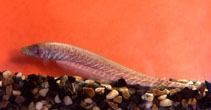http://www.fishbase.org/Summary/speciesSummary.php?genusname=Gymnotus&speciesname=carapo ---> http://192.134.151.83/Summary/speciesSummary.php?genusname=Gymnotus&speciesname=carapo
http://192.134.151.83/Summary/speciesSummary.php?genusname=Gymnotus&speciesname=carapo ---> https://fishbase.mnhn.fr/Summary/speciesSummary.php?genusname=Gymnotus&speciesname=carapo
https://fishbase.mnhn.fr/Summary/speciesSummary.php?genusname=Gymnotus&speciesname=carapo ---> https://fishbase.mnhn.fr/summary/Gymnotus-carapo.html
Gymnotus carapo, Banded knifefish : aquarium

You can
sponsor
this page
Common name (e.g. trout)
Genus + Species (e.g. Gadus morhua)
-

-
About this page
-
Languages
-
User feedbacks
-
Citation
-
Uploads
-
Related species
-


 Banded knifefish
Upload your
photos
and
videos
Banded knifefish
Upload your
photos
and
videos
Pictures
|
Google image
 Gymnotus carapo
Gymnotus carapo
Picture by
Landines, M.
Teleostei (teleosts) >
Gymnotiformes
(Knifefishes) >
Gymnotidae
(Naked-back knifefishes) > Gymnotinae
Etymology:
Gymnotus:
Greek, gymnos = naked (Ref.
45335
)
.
More on author:
Linnaeus
.
Environment: milieu / climate zone / depth range / distribution range
Ecology
Freshwater; benthopelagic; pH range: 6.0 - 7.5; dH range: ? - 15; potamodromous (Ref.
51243
). Subtropical; 22°C - 28°C (Ref.
1672
)
Central and South America: southern Mexico to Paraguay, including Trinidad.
Length at first maturity / Size / Weight / Age
Maturity: L
m
19.4
, range 25 - ? cm
Max length : 76.0 cm TL male/unsexed; (Ref.
79585
); max. published weight: 1.2 kg (Ref.
79585
)
Facultative air-breathing (Ref.
126274
); Aggressive (Ref.
27188
). Inhabits turbid slow moving or standing waters (Ref.
11225
). Found also in shallow edges of streams (Ref.
75964
). Can survive when ditches, canals and small ponds dry out. (Ref.
11225
). Feeds mainly at night on worms, insects (e.g. odonate larvae), shrimps, fish (preferably small characids, e.g.
Ctenobrycon
and
Curimata
) and plant matter (Ref. 7020;
10011
). Oviparous (Ref.
205
). Mouth brooding by males is observed in this species (Ref.
55570
). Males provide parental care in nests excavated for eggs and larvae (Ref.
55570
). Uses its long anal fin for locomotion. Can distinguish between a `friendly neighbor' and a potentially `threatening stranger' based on electric organ discharge (EOD) waveform alone (Ref.
10011
). Relationship between EOD pattern and agonistic behavior in this species has been demonstrated (Refs. 10531, 10532, 10533). Shows auditory abilities, responding best to a frequency of 1000 Hz, with an upper limit above 5000 Hz (Ref.
10831
). Also responds to vibratory stimuli (water waves: 125-250 Hz) with transient increase in EOD rate (Ref.
10834
). 'Prefers' temperatures of 24-25°C (Ref.
10836
).
Life cycle and mating behavior
Maturity
|
Reproduction
|
Spawning
|
Eggs
|
Fecundity
|
Larvae
Parental care is provided by the male. The male sits on a depression with its anal fin expanded horizontally guarding a cluster of larvae. More larvae are spread out in leaf litter up to 2 m away (Ref.
55570
).
Campos-da-Paz, R.
, 2003. Gymnotidae (Naked-back knifefishes). p. 483-486. In R.E. Reis, S.O. Kullander and C.J. Ferraris, Jr. (eds.) Checklist of the Freshwater Fishes of South and Central America. Porto Alegre EDIPUCRS, Brasil. (Ref.
36692
)
IUCN Red List Status (Ref.
130435
)
Least Concern (LC)
; Date assessed:
09 July 2018
CITES
Not Evaluated
Not Evaluated
Threat to humans
Harmless
Human uses
Fisheries: of no interest; aquarium: commercial
FAO - Publication:
search
|
FishSource
|
More information
Countries
FAO areas
Ecosystems
Occurrences
Introductions
Stocks
Ecology
Diet
Food items
Food consumption
Ration
Common names
Synonyms
Metabolism
Predators
Ecotoxicology
Reproduction
Maturity
Spawning
Spawning aggregation
Fecundity
Eggs
Egg development
Age/Size
Growth
Length-weight
Length-length
Length-frequencies
Morphometrics
Morphology
Larvae
Larval dynamics
Recruitment
Abundance
BRUVS
References
Aquaculture
Aquaculture profile
Strains
Genetics
Electrophoreses
Heritability
Diseases
Processing
Nutrients
Mass conversion
Collaborators
Pictures
Stamps, Coins Misc.
Sounds
Ciguatera
Speed
Swim. type
Gill area
Otoliths
Brains
Vision
Tools
Bio-Quiz
|
E-book
|
Field guide
|
Length-frequency wizard
|
Life-history tool
|
Point map
|
Classification Tree
|
Catch-MSY
|
Special reports
Check for Aquarium maintenance
|
Check for Species Fact Sheets
|
Check for Aquaculture Fact Sheets
Download XML
Summary page
|
Point data
|
Common names
|
Photos
Internet sources
AFORO (otoliths) |
Alien/Invasive Species database
|
Aquatic Commons
|
BHL
|
Cloffa
|
BOLDSystems
|
Websites from users
|
Check FishWatcher
|
CISTI
|
Catalog of Fishes
:
genus
,
species
|
DiscoverLife
|
ECOTOX
| FAO - Publication:
search
|
Faunafri
| Fishipedia |
Fishtrace
| GenBank:
genome
,
nucleotide
|
GloBI
|
Google Books
|
Google Scholar
|
Google
| IGFA World Record |
MitoFish
|
National databases
|
Otolith Atlas of Taiwan Fishes
|
PubMed
| Reef Life Survey | Socotra Atlas |
Tree of Life
| Wikipedia:
Go
,
Search
| World Records Freshwater Fishing |
Zoobank
|
Zoological Record
Estimates based on models
Phylogenetic diversity index (Ref.
82804
): PD
50
= 0.5000 [Uniqueness, from 0.5 = low to 2.0 = high].
Bayesian length-weight: a=0.00380 (0.00292 - 0.00495), b=2.93 (2.85 - 3.01), in cm total length, based on LWR estimates for this species (Ref.
93245
).
Trophic level (Ref.
69278
): 3.6 ±0.56 se; based on food items.
Generation time: 3.6 ( na - na) years. Estimated as median ln(3)/K based on 2
growth studies.
Resilience (Ref.
120179
): Medium, minimum population doubling time 1.4 - 4.4 years (tm=2).
Fishing Vulnerability (Ref.
59153
): Moderate vulnerability (37 of 100).
Nutrients (Ref.
124155
): Calcium = 51.3 [21.6, 112.8] mg/100g; Iron = 0.975 [0.510, 1.782] mg/100g; Protein = 18.3 [17.1, 19.6] %; Omega3 = 0.33 [0.13, 0.83] g/100g; Selenium = 25.6 [9.8, 63.4] μg/100g; VitaminA = 21.8 [6.9, 67.1] μg/100g; Zinc = 1 [1, 1] mg/100g (wet weight);
Back to Search
Random Species
Back to Top
Accessed through:
Not available
FishBase mirror site :
localhost
Page last modified by :
mrius-barile
- 20 July 2016
Fatal error
: Uncaught ArgumentCountError: Too few arguments to function checkEcotox(), 1 passed in /var/www/html/summary/speciessummary.php on line 2304 and exactly 3 expected in /var/www/html/includes/speciessummary.lib.php:2579 Stack trace: #0 /var/www/html/summary/speciessummary.php(2304): checkEcotox() #1 {main} thrown in
/var/www/html/includes/speciessummary.lib.php
on line
2579
|